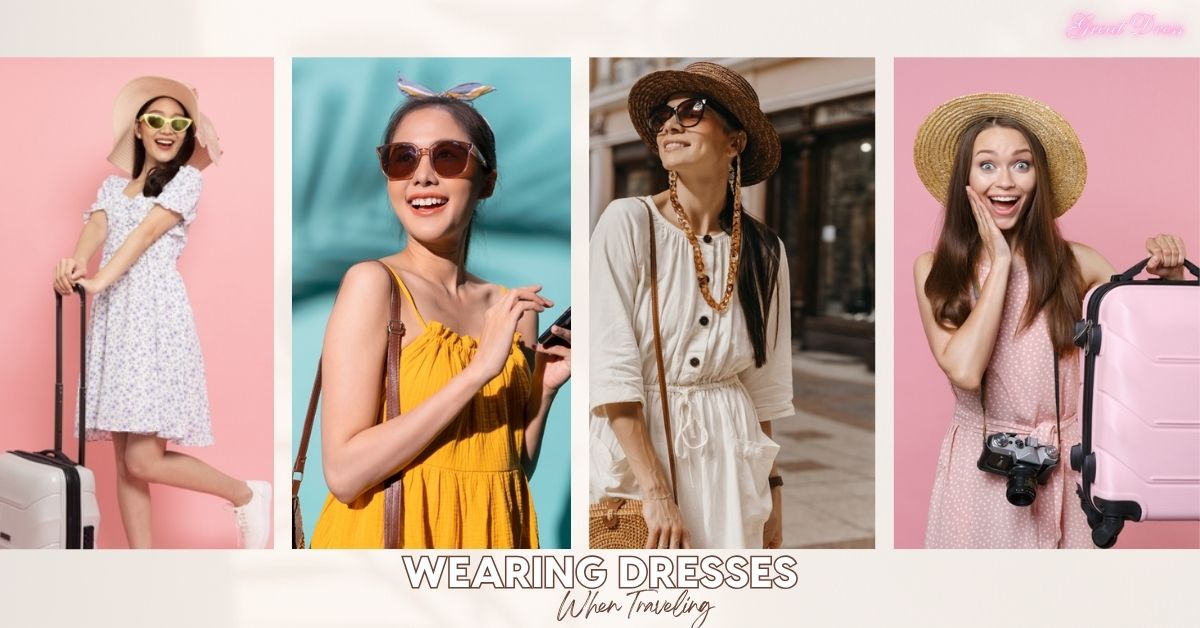Traveling often forces us to pack strategically—after all, luggage space is limited, and we want clothes that are both stylish and functional. The question “Should you wear dresses when traveling?” is more than a style dilemma. It’s a question about what kinds of clothing serve you best in terms of comfort, practicality, and versatility. In this comprehensive guide, we’ll dive into the pros and cons of dresses on the road, real-world advice, and actionable tips to help you decide what—and when—to wear them.
In this article, you’ll discover how to choose travel-friendly dresses, when they make sense (and when they don’t), and how to style and pack them so they work for long days, different climates, and changing plans. By the end, you’ll feel very clear on whether to wear dresses when traveling, and how to do it in a way that’s both smart and stylish.
Why Consider Wearing Dresses When Traveling?
Before diving in, let’s look at why dresses might be a surprisingly strong travel choice—and what trade‑offs you should know.
The Upsides: Why Dresses Can Be Ideal for Travel
-
Simplicity and Ease
Dresses are a one-piece outfit: you don’t need to coordinate tops and bottoms, which simplifies packing and getting dressed on the go. -
Versatility
With the right cut and fabric, dresses can work for many scenarios—from sightseeing during the day to dinner at night. Convertible dresses (adjustable straps, wrap styles) are particularly flexible. -
Comfort
Breathable fabrics like cotton, linen, or Tencel help regulate temperature. Great Dress notes that fabric choice is key: breathable materials keep you cool, while wrinkle-resistant ones help maintain your look after being packed. -
Lightweight Packing
Many travel dresses are wrinkle-resistant, lightweight, and compressible, making them ideal for packing tightly. -
Cultural Adaptability
In certain destinations, dresses (especially midi or maxi styles) can offer modest coverage, helping you respect local dress codes or religious norms. -
Stylish While Functional
You can find dresses with hidden pockets, adjustable ties, or convertible designs, which means you don’t have to sacrifice utility for fashion.
The Downsides: When Dresses Might Not Be the Best Choice
Even though dresses have many benefits, they’re not a universal solution. Here are some potential drawbacks.
-
Limited Layering Options
You might find it harder to layer dresses, especially in colder or more variable climates. Pants can offer more flexibility. -
Modesty & Cultural Constraints
In some conservative destinations, dresses that are too short or revealing might be inappropriate or draw unwanted attention. AARP’s travel fashion guide warns against overly revealing or clingy garments. -
Wrinkling Concerns
Not all dresses are wrinkle-resistant. If you pack delicate or non-performance fabrics, they may crease badly unless handled with care. That said, there are packing techniques to mitigate this. -
Restricted Mobility
Some dress styles (tight cuts, pencil skirts, etc.) may restrict movement—especially if you’re hiking, climbing stairs, or walking long distances. -
Overpacking Risk
Relying only on dresses can lead to overpacking if you want a variety of outfits for different occasions. One traveler noted needing multiple dresses for a short trip just to cover different events. > “I felt I needed FOUR dresses … for travel days, a conference, and an evening event.” -
Maintenance
Depending on the fabric, dresses may require special washing or care. If you’re traveling long-term without access to laundry services, lightweight, easy-care dresses are essential.
How to Make Dresses Work for Travel: Practical Tips
If you decide to wear dresses when traveling, here’s a step-by-step guide to making sure your choices are smart and practical.
1. Choose the Right Fabrics
-
Breathability: Opt for natural or semi-natural fibers like cotton, linen, or Tencel/lyocell. These materials breathe well, which is especially helpful in hot climates.
-
Wrinkle Resistance: Consider jersey, modal, synthetic blends, or performance fabrics that hold up well after being packed tightly.
-
Quick-Dry: If you want to wash mid-trip, look for fabrics that dry quickly. Performance fabrics and lightweight synthetics excel here.
-
Natural vs Synthetic: Natural fibers are safer in emergencies (synthetics like polyester or nylon can melt).
2. Pick Smart Dress Styles
Select styles that are travel-friendly:
-
Wrap Dresses: Adjustable waist, flattering for many body types, and easy to style up or down.
-
Maxi Dresses: Provide coverage, versatile for day or night, and often made with flowy, breathable fabric.
-
Shift or A-Line: Roomy cuts that allow for movement and comfort.
-
Convertible or Adjustable Features: Straps that convert, hems that snap or ruche, adjustable waist ties — all make a dress more adaptable.
-
Pockets: Hidden pockets save you from carrying extra bags. Journée highlights this as a huge plus.
3. Build a Travel Capsule Wardrobe
Rather than packing tons of dresses, build a small, cohesive travel wardrobe:
-
Choose 2–3 versatile dresses: e.g., a midi wrap dress, a casual jersey mini, and a more formal maxi.
-
Complement with a few layering items: a cardigan, a jacket, a scarf.
-
Include other pieces (if needed): leggings, pants, or shorts for variety or layering in cooler weather.
-
Neutral color palette: helps you mix and match more easily.
4. Pack Smartly to Avoid Wrinkles
Wrinkles can ruin a dress, but with good packing, you can minimize creases:
-
Roll, don’t fold: Rolling garments helps reduce wrinkles and saves space.
-
Use packing cubes: Keep dresses separate and compressed without crushing them.
-
Tissue paper or garment bags: Layer tissue between delicate fabrics or use garment bags for special dresses.
-
Steam on arrival: Use the hotel shower’s steam to release wrinkles, or bring a small travel steamer.
5. Layer Strategically
Depending on your destination and climate:
-
Bring a light cardigan or shawl for chillier evenings or for modesty in conservative areas.
-
Use leggings or tights underneath dresses for warmth, especially on planes. A flight attendant even recommended tights under dresses.
-
Use performance underlayers (like moisture-wicking base layers) if you’re hiking or walking a lot.
6. Style for Day-to-Night Versatility
-
Accessories: Change shoes, belts, or jewelry to shift the mood.
-
Convertible Dresses: Use wrap or adjustable features to turn a casual day dress into an evening look.
-
Layer on top: Add a blazer, jacket, or cardigan for a more polished look.
7. Care on the Go
-
Travel laundry kit: Pack a small laundry soap and a universal sink stopper so you can wash dresses mid-trip.
-
Spot clean: Tackle stains quickly with a travel-size stain remover.
-
Hang dry: Use hangers or air-dry to maintain shape and avoid shrinkage.
When Wearing Dresses While Traveling Works — and When It Doesn’t
Let’s look at some practical examples to illuminate when dresses are a smart travel choice — and when you might want to skip them.
Scenario 1: European City Break (Spring / Summer)
Why do dresses shine here?
-
Lightweight midi or wrap dresses keep you cool and stylish while walking through cobblestone streets.
-
You can easily layer a cardigan or scarf for church visits or cooler evenings.
-
Pockets help you carry essentials like your phone or travel card.
Cautions:
-
Bring comfortable walking shoes — flats or low-heel sandals may work better than strappy heels.
-
Use a lightweight jacket if rain is expected.
Example: A traveler in Lisbon wears a breathable linen midi dress during the day, then pairs it with a denim jacket and slip-on shoes for an evening meal.
Scenario 2: Tropical Beach Vacation
Why dresses are ideal:
-
Maxi or sundresses in linen or jersey are perfect for beach walks and dinner by the water.
-
Convertible straps or tie-waist dresses transition easily from day to night.
-
Dresses dry quickly after being rinsed — useful if you’re washing beachwear by hand.
Cautions:
-
Bring a cover-up or scarf for sun protection or modesty when needed.
-
Pack wrap dresses or loose cuts to avoid clinginess in humid weather.
Scenario 3: Business Travel / Conference
Why dresses might work:
-
A shift or wrap dress offers a polished, put-together look with minimal effort.
-
Less need to coordinate separate pieces simplifies your packing.
-
Dresses with pockets can hold essentials like business cards or your phone.
Cautions:
-
Choose wrinkle-resistant materials to stay sharp even after being packed.
-
Bring a blazer or cardigan for formal meetings or changing temperatures.
Scenario 4: Backpacking or Hiking Trip
When dresses may not be the best choice:
-
Mobility is key: Pants or leggings may perform better during long hikes or rough terrain.
-
Dresses may not provide enough coverage for bug protection, depending on style and destination. According to REI, long pants are often better for sun, rain, and insect protection.
-
Layering can get tricky, especially if it’s cold or windy.
Alternative: Use dresses for rest days or relaxed evenings, and pack functional pants or leggings for active days.
Discover Your Perfect UK Getaway with Holidu
Looking for a getaway that feels effortless from start to finish? Holidu makes it simple to discover stunning holiday homes across the UK or anywhere in the world, whether you’re craving a quiet cottage or a coastal escape. With smart search tools and trusted reviews, you can find the perfect stay in just a few clicks. Visit holidu.co.uk today and turn your travel plans into unforgettable memories.
Common Mistakes & Pitfalls When Wearing Dresses on the Road
Here are some frequent missteps to avoid:
-
Choosing the Wrong Fabric
-
Mistake: Packing delicate silk dresses that wrinkle badly or take forever to dry.
-
Better: Choose wrinkle-resistant and quick-dry fabrics.
-
-
Overpacking Too Many Dresses
-
Mistake: Bringing five dresses for a 5-day trip, leaving no space for layering pieces.
-
Better: Build a capsule wardrobe with a mix of dresses + versatile layering items.
-
-
Ignoring Local Norms
-
Mistake: Wearing very short or revealing dresses in conservative areas.
-
Better: Research dress codes and cultural expectations before packing.
-
-
Not Considering Mobility
-
Mistake: Wearing a tight, pencil skirt-style dress to walk long distances.
-
Better: Choose A-line, wrap, or shift dresses that allow for movement.
-
-
Packing Without Care
-
Mistake: Folding dresses carelessly, resulting in deep wrinkles.
-
Better: Roll clothes, use packing cubes, or use tissue paper to protect delicate pieces.
-
-
Neglecting In-Trip Care
-
Mistake: Not having any access to laundry or stain care, so dresses get dirty quickly.
-
Better: Bring a lightweight laundry kit, and hang dresses to dry or steam them after packing.
-
FAQs: Answering Common Questions About Wearing Dresses While Traveling
Q: Is it safe to wear dresses on a plane?
A: Yes — in fact, many travelers prefer dresses on flights. For example, some choose loose-knit dresses with elastic waists to accommodate bloating, and they layer with tights or cardigans for warmth. Also, avoid tight synthetic clothes like leggings in case of an emergency: natural-fiber dresses are a safer pick.
Q: Will dresses wrinkle too much in luggage?
A: Not if you pack smart. Rolling dresses, using packing cubes, and choosing wrinkle-resistant fabrics go a long way. You can also steam wrinkles out using hotel steam or hang dresses in the bathroom while you shower.
Q: What if I’m traveling to a conservative country?
A: Choose dresses with modest cuts (longer hemlines, sleeves) and pair with scarves or cardigans. Research local dress customs and err on the side of respectful rather than trendy.
Q: Do dresses take up too much space compared to pants?
A: Not necessarily. A few well-chosen dresses can replace multiple top–bottom combinations, saving space — especially if they’re lightweight and roll easily.
Q: What shoes should I pair with travel dresses?
A: Comfortable walking shoes are key. Depending on the dress and destination, consider flats, low-heel sandals, espadrilles, or even sneakers for practicality.
Seasonal & Context-Specific Considerations
Here’s how to adapt the choice to different travel contexts and seasons:
| Travel Context | Dress Strategy |
|---|---|
| Hot / Tropical Destinations | Use lightweight, breathable fabrics like linen or cotton. Go for flowy cuts (maxi or wrap) and pack a cover-up or scarf for modesty. |
| Cold / Variable Weather | Layer dresses with tights/leggings, a sweater or fleece, and a waterproof jacket. Choose heavier-knit dresses or performance fabrics. |
| Business or Formal Trips | Pick wrinkle-resistant dresses in neutral colors. Bring a blazer or cardigan. Use a steamer or hang dresses on arrival. |
| Backpacking or Hiking | Limit dresses to rest or casual days. Prioritize mobility by choosing stretchy or looser cuts. Pack performance pants for active legs. |
| Cultural / Religious Sites | Opt for modest hemlines and sleeves. Use a scarf or cardigan to cover up when needed. |
Expert Opinions & Insights
-
According to REI’s expert advice, performance fabrics (like polyester blends, Tencel/lyocell) are often more travel‑friendly than cotton, thanks to their moisture-wicking properties and wrinkle resistance.
-
AARP’s travel-style guide warns against tight synthetic clothes (e.g., skinny jeans, clingy tops) and recommends breathable natural fabrics and looser cuts for both comfort and cultural respect.
-
Travel stylists also suggest dresses with adjustable features like ties or convertible elements so they can serve multiple purposes on a trip.
Personal Stories & Real Traveler Feedback
-
One frequent flyer shared on Reddit: “I travel in a knit maxi dress with a cardigan … It’s more breathable than sweatpants… I feel a little more elevated.” Reddit
-
Another traveler mentioned that bloating during long flights makes elastic-waist or wrap dresses a much more comfortable choice than restrictive pants:
“I have two really nice … black tank dresses … I pair with cardigans … I bloat like crazy … elastic waistbands get very uncomfortable.” Reddit
-
A minimalist-traveler thread noted how dresses limited their outfit variety:
“I need FOUR dresses … to account for travel days, … three days of conferences, and changing for the one evening event.” Reddit
This underlines the importance of balancing dresses with other pieces in a capsule wardrobe.
Final Thoughts: Should You Wear Dresses When Traveling?
The answer, simply put, is: yes—sometimes. Dresses can be a powerful tool in your travel wardrobe toolkit. When chosen and styled thoughtfully, they offer unmatched ease, flexibility, and comfort. With the right fabric, cut, and packing strategy, you can make dresses do a lot of heavy lifting, letting you pack lighter and look better on the road.
That said, they’re not a silver bullet. If your trip involves rugged terrain, unpredictable weather, or very conservative environments, you’ll likely need other garments—like pants or performance layers—in your rotation. The key is balance: using dresses where they shine, and supplementing them with smart alternatives.
Actionable takeaway: Try building a small travel capsule that includes 2–3 well-chosen dresses (wrap, midi, maxi), a layering piece (cardigan or jacket), and a pair of flexible pants or leggings. Use smart packing techniques like rolling and packing cubes, and choose breathable, wrinkle-resistant fabrics. This way, you can confidently decide whether you’ll wear dresses when traveling, and do so in a way that’s both stylish and practical.



